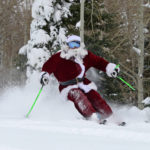Making Smokey Bear Proud
Steamboat’s Wildfire Mitigation Plan Maintains Healthy Forests
Gliding through a Colorado wildfire season safely and with healthy forests is a focused, calculated group effort. As the western U.S. drought surges on and summer storms bring lightning strikes and the occasional careless firework and rogue cigarette butt, Steamboat Resort mitigation teams keep a close pulse on risk management.
“We’ve had a couple of close calls up here, almost all started by improper disposal of cigarette butts. We really try and educate guests to be responsible,” says Steamboat Director of Mountain Operations Corey Peterson.
Peterson oversees the resort’s 2,965 acres, a portion of which rests on Forest Service land. His dedicated summer mountain operations team works daily to cut down dead trees and keep long grass mowed to mitigate fire risk. But natural wildfire starters, like lightning, are always a threat. So taking down dead or “hazard” trees — one that is ready to fall, for example — is crucial.
“A big part of our forest health is fuel control,” says Peterson. His crew follows a clear Forest Service vegetation management plan that outlines what they can and cannot cut down. One Steamboat resort summer crew of 20 runs chainsaws and removes brush and hazard trees from ski trails, while a fall crew tackles mowing.
Summer mountain operations buzz along with trail crews, construction workers, bike patrollers, lift maintenance and lift operators. Every staff member that drives a truck on the mountain carries a fire kit that includes a shovel, a rake and a five-gallon piston pump. Steamboat staff undergoes specialized fire safety trainings, including a recent scenario exercise where staff simulated an actual fire, engaging with stakeholders and incident command teams. They work closely with the local Forest Service and Steamboat Fire Department to host annual all-team trainings.
The Steamboat resort crew has successfully tackled a couple of small fires that have broken out on resort property. “Luckily we caught them early,” Peterson says. But if anything significant were to crop up, the Forest Service and local fire department would take over with Steamboat resort crews serving as support.
Thankfully, this summer kicked off with a wet spring and has maintained solid moisture. “Hopefully that continues,” says Peterson “These past two years, we were already under two fire restrictions at this point in July.”
Heavy spring moisture is a double-edged sword — lots of rain followed by sun means taller vegetation growth, which means higher fire risk. Alongside Steamboat’s steadfast mitigation crew resides a certain level of visitor stewardship. Peterson offers guests a few fire safety nuggets:
- If you’re going to smoke, do so in marked designated areas and extinguish and dispose of it in a fireproof receptacle.
- Please remember, fireworks and sparklers are prohibited on the mountain.
- Be aware. Keep your eyes peeled on the mountain and if you see smoke, call 9-1-1 immediately and try and determine the precise location of the fire and what the fire is doing so you can relay proper info.
- If you’re in the middle of the forest and a fire starts, move downhill. Fires tend to work uphill.
- Keep an eye on fire restrictions — they can change day to day, county to county — and only have a campfire when permitted.
What do fire restrictions mean?
Fire restrictions are used to limit certain activities on national forests and grasslands during periods of extreme fire risk. Fire restrictions have various levels called stages. Each stage limits specific activities and can vary from place to place, even those areas in close proximity. Know before you go on that trip to visit our national forest or grasslands. Check with local forest and fire agencies to see if any fire restrictions are in place.
Why are campfires a concern? During times of extreme fire risks and conditions, campfires can easily escape a fire ring, potentially becoming a wildfire. Our firefighters’ and public safety are top priority. It is critically important for all resort guests to be observant of any signs of smoke or fire. If you suspect or see smoke or fire report your observations to Routt County Dispatch 911.
Stage 1
During Stage 1 fire restrictions, certain activities may not be allowed and/or may be restricted to an area. For the USDA Forest Service Rocky Mountain Region, the following activities may be limited or not allowed during Stage 1. Generally, campfires are only permitted within a provided steel ring at improved campgrounds. Personal portable wood/charcoal fire pits/rings, often made of stainless steel are prohibited. Smoking is permitted in vehicles on roads, in an approved building or cleared areas at least 3′ in diameter, or on boats on rivers and or lakes.
Stage 2
During Stage 2, fire restrictions are more restrictive than Stage 1 restrictions. For the USDA Forest Service Rocky Mountain Region, the following activities may be limited or not allowed during Stage 2. Campfires are prohibited unless you have propane fueled stoves or heating devices that have an on/off switch. Smoking is permitted in vehicles, trailers, or in an approved building.
Always check with the local Forest Service office to determine what specific restrictions are in place.



